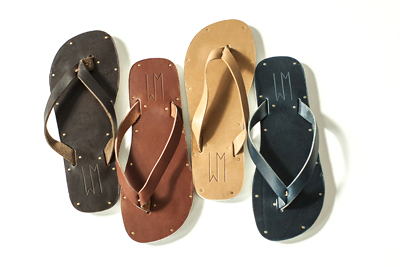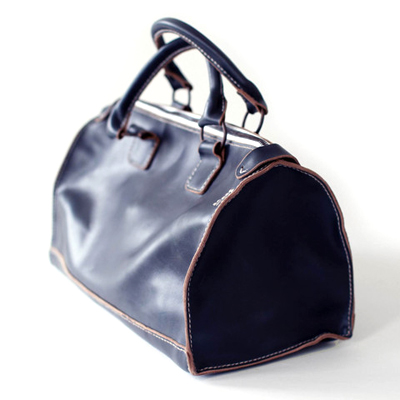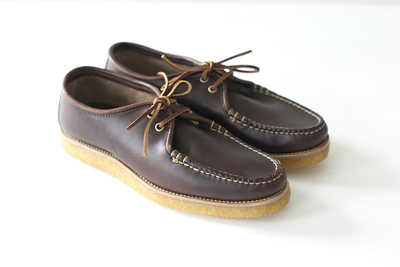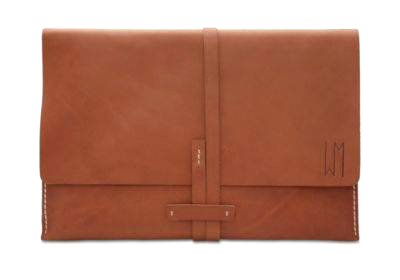If you’re looking for that rare, special gift to give this season, look no further than Waltzing Matilda. Unapologetically crafty and yet exquisite, Mike Balitsaris’s handcrafted leather sandals, bags and accessories are simply some of the most original-looking accessories on the market imbued with the memory of, say, the greatest makers of leather goods in pre-Industrial America. In a twist of irony, one of the brand’s most memorable products happens to be built for technology—the Avery laptop sleeve, with its signature wraparound tie, launched the brand last December on Apple’s website and continues to be sold on the website today. Meanwhile, 90% of the materials, as well as the tools, Balitsaris (above) uses, remain repurposed, incorporating a variety of inspirations from Native American culture to Ancient Greece and the Wild West. The made in America line doesn’t stop at cases. There is now footwear, jewelry, carryalls and more. Here, our recent conversation with the super talented designer behind next year’s brand to watch.
Waltzing Matilda was my choice for a couple reasons. “Waltzing Matilda” is a song title and the song is the unofficial national anthem of Australia. However, the way I know it is through the American singer/songwriter, Tom Waits. He sings “Waltzing Matilda” in his song, “Tom Traubert’s Blues.” I grew up listening to my dad play that song on his record player and always loved the balance of the way Tom Waits’s gruff, whiskey-soaked voice mixed with his beautiful piano chords. I think my pieces have that mix of hard/toughness mixed with a little sweetness and they blend well most of the time. The other reason is the meaning of “Waltzing Matilda” in both songs’ context. As it was explained to me, a “Matilda” is slang for a hobo’s bundle of possessions on the end of a walking stick, and the idea of “Waltzing Matilda” is the vision of seeing a hobo walking along train tracks with his bundle over his shoulder, swaying side to side (dancing a waltz) from having too many libations.
So just how did you get into crafting?
I started working with leather when i was in my early 20s. I had just returned from backpacking through Europe for the summer and had purchased a great pair of sandals when I was in Greece. Long story short: after much wear, I needed a new pair but couldn’t find anything in stores (no Internet then, boys and girls.) So I went to my neighborhood shoe cobbler and asked if he could give me a hand with making a pair. He gave me some scrap leather and a baby food jar full of glue and told me to figure it out. I came back with a bad version the first time, but he was nicer the next time I went back and gave me some additional pointers. Finally, at some point I had a pair of sandals made. Then a friend wanted a pair and I guess the seeds of the business were planted.

What I mean by this is: going out into the woods and coming back with a tree branch and figuring out how someone thousands of years ago would have made a sling shot out of a stick like the one you are holding, and then making one yourself and having it work. That vs. going to the store and buying some cheap one from another country, and the second time you sling a rock the thing breaks in your hand. As far as the leather work I do, I started stitching by poking a hole in the leather with an awl, then putting the thread through, and then poking another hole, etc. It’s basic, simple, minimalistic and produces great quality products. The process has become almost like meditation to me. A lot of the tools I use are a hundred years old or close to it—again, basic and simple, but they get the job done. I remember being little and seeing men in my neighborhood working in their garages on their cars or making a cabinet for their kitchen. The best guys were using the simplest tools and that always struck me. They had a hammer or a wrench or a hand-saw and a ruler, and the stuff turned out amazing. Their success was in their soul. You can’t teach the kind of pride that making something from scratch with your own hands gives you.
Where do you source from?
I started by trading with guys who worked in shoe factories—I’d give them beer for leather. As I started to get more orders, I found a guy in Queens who traded in seconds (leather that didn’t make it to the shoe factory because of marks) and I liked the way the seconds looked with brands and scuffs on the leather. I thought it added character. I’ve also come across materials by digging through warehouses and finding gems like the Ammo Cases I have reconstructed. I also work with a couple tanneries in the USA who supply leather for me.

Besides the sandals, which are a spring/summer thing, right now most of my pieces are core items that stay in stock season to season. Again, back to simple, minimal, basic—we want pieces to be usable at any time of the year. But, in addition to core items, we do come up with items that would be great for a specific summer event, for example. And from there we make something that will work best for that purpose and, if I like it enough, it becomes part of the line. I didn’t set out initially to create a “line.” I didn’t even know what a linesheet was 12 months ago (or six months ago, frankly). I came about this organically by just making stuff that I couldn’t find or by recreating something cool that I saw and trying to make my own mark on that thing.
What products are your bestsellers now?
The Aspen bags, Wine bags, Nica sandals, the Avery and Riley laptop bags, which are sold on Apple’s website.

I have been making a lot of hand-forged silver bracelets and rings that are really great. I also have four new sandal styles that we’ll be bringing to the line, as well as a number of one-of-a-kind pieces I’m making out of vintage leather and fabric. There’s a vintage-style boat shoe that will be out this spring. That style uses reclaimed die casts from the 1930s that we found on one of our “field trips.”
How do you ultimately see yourself growing the brand?
I am trying to make this a business that is able to support itself so that me and the people who work with me can make a living at it. Mostly, we are growing organically through word of mouth. I know that I would be happy doing what I’m doing now for the rest of my life, provided that I can afford it, so that’s the primary goal. That said, I love the idea of collaborating with other brands and stores and learning from them.

I’ve seen a fundamentally positive change in the way people think about where and how things are made now vs. 20 years ago or even 10 years ago. If people take the time to understand the positive impact of what “made here” really means, then they will support the folks who are trying to make a living doing what I’m doing. The young people coming out of school now seem to really get it and are fueling the USA “made here” businesses, and that’s great to see. Like almost everything, the movement will evolve by each success building off itself. If somebody like me is successful, then it potentially provides hope to the next person who is risking a lot to find their passion and follow their soul. Pockets of success start to spawn more small communities that are successful, and so on. For example, if I’m successful and I can hire some more like-minded people to help me, we will need a place to eat near our shop and that will provide another opportunity for someone. Then we will get parched and need something to drink and that will create the opportunity for, say, a micro-brewery. Then who knows what else.



